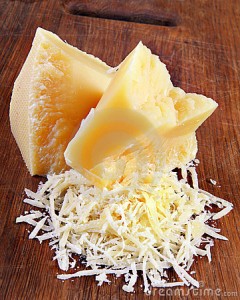In Australia, the name parmesan is applied to a range of hard cheeses, including those sold as small vacuum-packed wedges or pre-grated in containers. Many of these products have a texture ranging from leathery to firm, with either no discernible smell or a distinctive ‘baby burp’ aroma. The only thing these have in common with real Italian parmesan is that they are made from cow’s milk.
 True Italian parmesan, parmigiano reggiano, is a hard, fine-grated, strong-tasting cheese made only in Italy. It is in the style of grana cheeses, which are cooked rather than pressed to expel water from the curds. Only cheesemakers in a few select provinces who use techniques that have remained unchanged since the 13th century may officially sta,p the rinds of their cheeses with the parmigiano reggiano name.
True Italian parmesan, parmigiano reggiano, is a hard, fine-grated, strong-tasting cheese made only in Italy. It is in the style of grana cheeses, which are cooked rather than pressed to expel water from the curds. Only cheesemakers in a few select provinces who use techniques that have remained unchanged since the 13th century may officially sta,p the rinds of their cheeses with the parmigiano reggiano name.When added to soups, soufflés, omelettes and bread, parmigiano reggiano adds a distinctive layer of flavour and, unlike its pretend parmesan counterparts, which tend to become stringy when heated, parmigiano’s creamy qualities can be used to great effort, particularly in dishes such as risotto. Chicken, veal and eggplant are traditionally served lightly coated in a parmesan crust or baked with a melted parmesan topping. Full-flavoured mushrooms, such as portobello, also benefit from a shave or two of parmesan.
Aged parmigiano can really make a difference to pasta dishes, elevating them from excellent to sublime. However, Italians do frown on the Australian tradition of sprinkling parmigiano on seafood pastas. Parmigiano reggiano can be enjoyed on its own, yet it is often ignored on restaurant cheese platter menus. Its rich, fruity flavour is perfect with fresh fruit or fig paste and a slice of crusty bread, or eaten with a traditional dip of balsamic vinegar.
